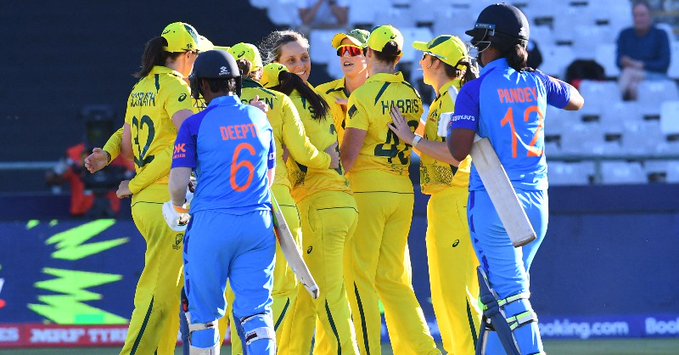
As magnificently as Harmanpreet Kaur and Jemimah Rodrigues batted, India’s atrocious display in the field wasn’t worthy of a place in the final.
This was a repeat of the T20 World Cup final of 2020 only in name. That game, played in front of a world-record crowd for women’s cricket at the Melbourne Cricket Ground, was a one-sided rout. This match at Newlands, in the shadow of Table Mountain, was in the balance until Shikha Pandey failed to clear the rope with the penultimate delivery. But in a way, this defeat will, and should, hurt India far more. When you’re comprehensively outplayed from start to finish, it’s easier to dust yourself off and move on. But when you lose after having had umpteen chances to win, the scars stay with you forever.
At the (50 over) World Cup final in 2017, India went from 191 for 3 to 219 all out while chasing 229 for victory against England. At the Commonwealth Games final in 2022, the collapse was from 118 for 2 to 152 all out. In Cape Town, India needed 41 from 33 balls, with six wickets in hand and Harmanpreet Kaur batting like a dream. How quickly it became yet another nightmare.
You’ll read reams in the coming days about how beautifully Jemimah Rodrigues and Harmanpreet batted, and how unfortunate they were to finish on the losing side. That isn’t wrong. But to focus on ‘luck’ as Harmanpreet did in her post-match interview is to ignore how shockingly poor India were in several aspects of the game. You don’t become a champion team like Australia with that attitude.
Luck plays a big part in both batting and bowling. On another day, Rodrigues might have ignored the bouncer that sailed way over her head, and waited for it to be called a wide. But she was in such a zone and striking the ball so sweetly that she could be forgiven for trying that ramp shot. On another day, it might have cleared Alyssa Healy.
Harmanpreet’s run-out was no different. You can debate till the cows come home about whether she could have run the second a bit more briskly. But remember that this is a woman who was so unwell she had to go to hospital on the eve of the game. Even if she wasn’t exactly running full pelt, there’s no way she would have been out but for the toe end of her bat getting snagged in the turf.
A bowler who sees a perfect yorker deflected for four off an inside edge can also bemoan her luck. But so much of India’s display in the field was just pitiful, and that had nothing to do with fortune. Batting and bowling performances depend on the opposition as well. Fielding and fitness are within your control, and India were found badly wanting in both departments.
Remember that this is no longer a team of plucky amateurs. These are professional cricketers, most of them on central contracts, with access to the best facilities available in Indian cricket. There really are no excuses for not being up to scratch.
You would have needed an Abacus or better to keep track of the fumbles and misfields from India as the Australian innings progressed. Ones became twos, simple catches became fours. Between them, Beth Mooney and Meg Lanning made 103 of Australia’s total of 172. Mooney had made 32 from 25 balls when she lofted Radha Yadav down the ground. It wasn’t a steepler, nor was it hit ‘like a tracer bullet’. Instead, it was a regulation catch for Shafali Verma, who barely had to move to get her hands on the ball. She palmed it across the rope for four.
Lanning, who would cut loose to devastating effect in the final overs, had 1 from two balls when she nicked Sneh Rana’s second ball behind. Again, a routine chance, the kind that are taken every day in training and matches across the land. Richa Ghosh spilled it. The luckless Rana was at the receiving end again in the 13th over. Lanning, then on seven, missed an off-break and should have been stumped by yards. But Ghosh fumbled the take, allowing Lanning back to the safety of the crease.
With the ball, the finish was just awful. Renuka Singh has been a star since she made her debut less than two years ago. She delivered India’s performance of the tournament in the loss to England in the group stage. But in her final over at Newlands, she dished out not one, but two full tosses. Both sailed way over the rope at deep square leg, and with the match being played in bright afternoon sunshine, there wasn’t even dew to blame for the lack of control and execution.
With the bat, Rodrigues and Harmanpreet showcased the best of modern-day cricket – crisp strokeplay, aggressive running between wickets and plenty of inventiveness. There was precious little else to savour. You could count at least a half dozen occasions where India dawdled over the first run and completely ignored the possibility of two. The quick singles and scampered twos that may have prompted some Australian panic never came.

When Rodrigues and Harmanpreet were at the crease, you could see how frazzled Australia were. But you don’t make it to seven successive finals by accident. The greatest all-round player in the history of women’s cricket made 2* on Thursday, and her only over with the ball went for 14 runs. But Ellyse Perry pulled off two stupendous stops on the boundary, and never looked like dropping Yadav when she skied one into the deep.
That is greatness. And you don’t arrive at it by accident. Perry played her first game for Australia more than 15 years ago. She was briefly a soccer international as well. There are a lot of miles in those legs, but she remains a supreme athlete. Those stops on the rope had nothing to do with luck. They were the result of thousands of hours of training. Don’t buy into the rubbish about ‘natural athletes’. Athleticism, agility, core strength and timing – everything that combined to stop those balls crossing the rope – come from bloody hard work.
There is the mental aspect too. Australia, like Real Madrid’s footballers and Michael Jordan’s Chicago Bulls, know how to win. They’ve been in these situations enough times to trust their judgment and instincts. Hopefully, with the exposure they get from the Women’s Premier League (WPL), some of the Indian girls will get there too. But without a much fiercer focus on fielding and fitness, this pattern of near-misses won’t be broken.




